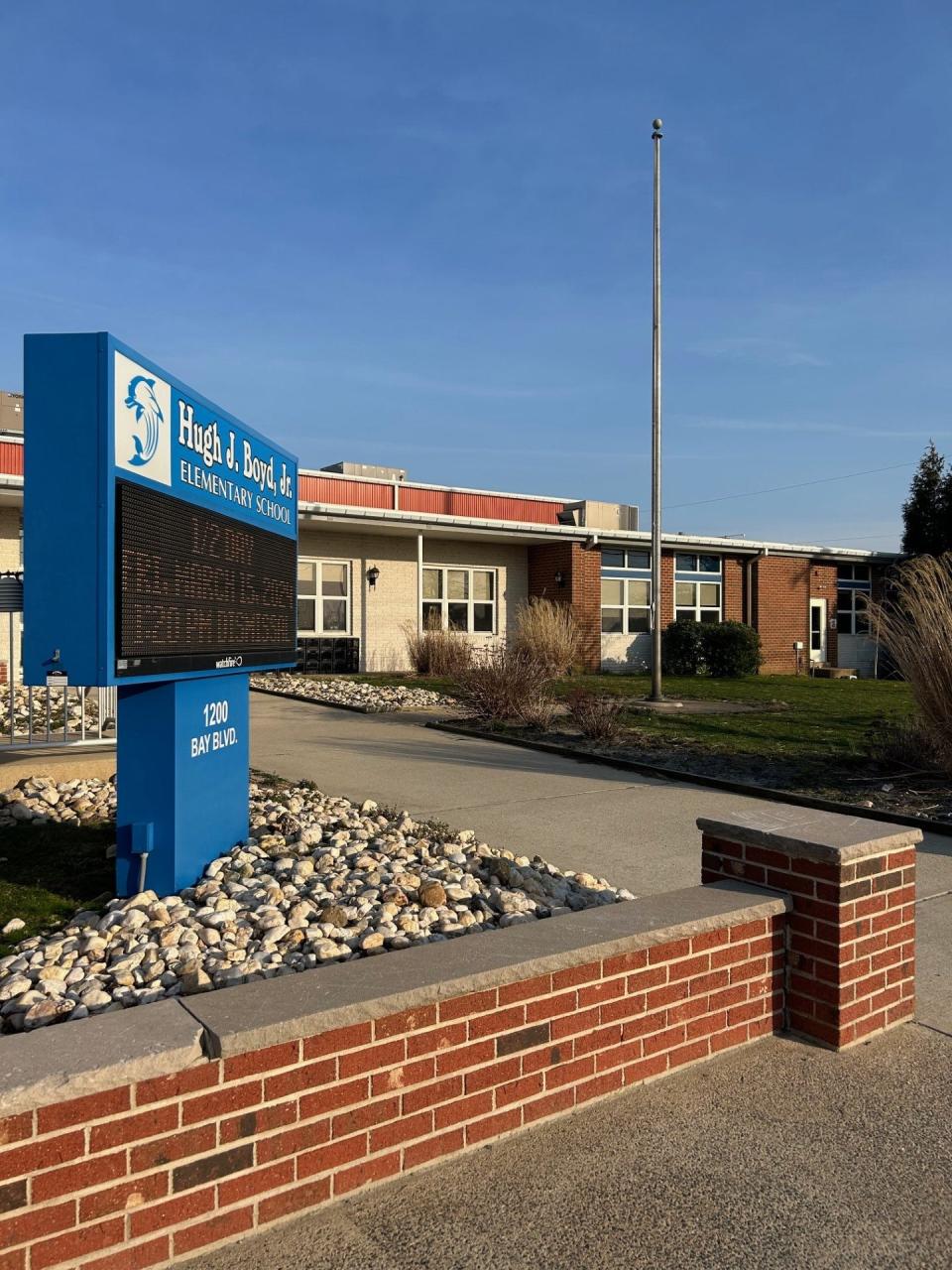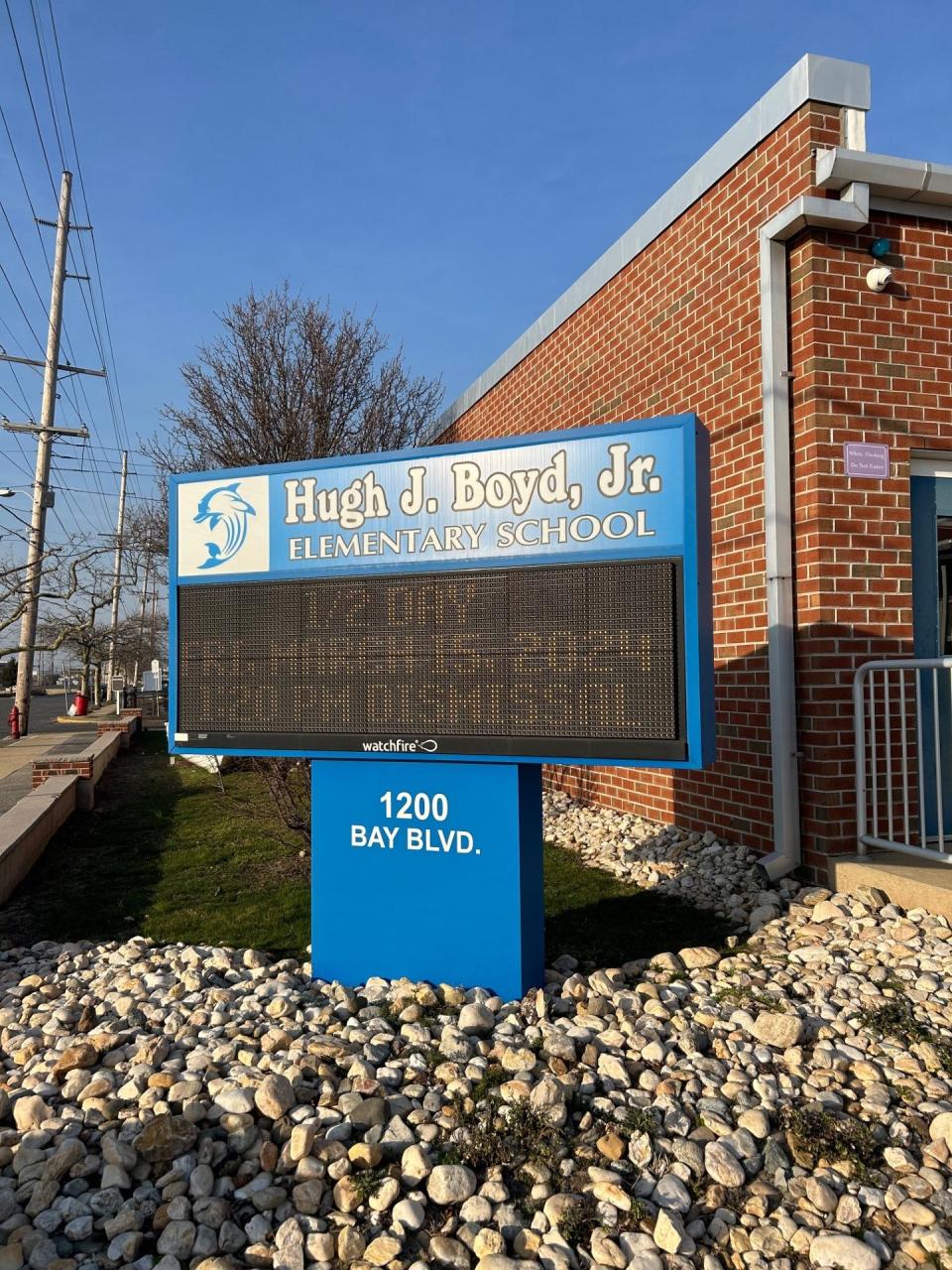Is Toms River merger worth it if that means Seaside Heights school is doomed?

SEASIDE HEIGHTS - Third graders at the borough's Hugh J. Boyd Jr. Elementary School recently expressed their worries about the potential shutdown of their neighborhood school. And they did it in rhyme.
Writing on pink paper hearts, the kids wrote about their love for the small neighborhood school, which could close in five years if the Toms River Regional and Seaside Heights school districts merge.
"Roses are red, lions like to roar, please don't shut, Hugh J. Boyd's door," reads one handwritten message. "Roses are red, my heart is broken, please, please please keep HJB open," another says. "Roses are red, our staff is cool, Hugh J. Boyd Jr. is the best school!" exclaims a third.
The children have had their say. Seaside Heights voters will get to cast ballots on the potential merger in an April 16 special election.
Teachers, parents and concerned residents gathered at the school last week to express their belief that keeping Boyd open indefinitely is the right thing for the community; they are encouraging residents to vote "no" on the referendum.
They argue that the small neighborhood school is the heart of Seaside Heights' local community, and say they don't believe its 200 children — in grades pre-kindergarten to sixth — will receive a better education "across the bridge" at East Dover Elementary in Toms River.

"We are all very devastated that this is going to happen," said Seaside Heights resident Lisa Franciosi. "We hope the building itself will stay open. We want to the vote to go in our favor, which means that people will vote 'no.'"
Big changes ahead: See what is replacing Seaside Heights hotspots Karma, Merge and more
'A family includes children'
Seaside's Borough Council has scheduled a special meeting for 6 p.m. April 4 for a "question and answer" session on the regionalization study. The meeting will be held in the municipal court room located on the second floor of the George E. Tompkins Municipal Complex, 116 Sherman Ave., above the firehouse.
"He wants to make this a family town," said resident Tom Oldewurtel, referring to Mayor Anthony Vaz's aim to make Seaside "family friendly." "I think this is a very big deal. A family includes children."
The Boyd school educates children in grades pre-K to sixth; middle and high school students attend Central Regional schools in Berkeley. If Toms River merges with Seaside Heights, the Boyd school would stay open up to five more years before students are moved to East Dover Elementary, about six miles away. Older students would attend Toms River Regional Intermediate East and High School East.
Norma Jarana, who graduated from Boyd and is a substitute teacher there, said many parents will not be able to vote in the upcoming referendum, because although they work and pay taxes, they are not U.S. citizens.
Tower delays: Seaside Heights expected work to start by now on a 10-story tower. So where is it?
"They will not have a vote and their children are the ones who are affected," Jarana said, estimating that more than 50% of Boyd parents will not be eligible to vote April 16. "They are a walking community. Many of the families don't have transportation." While she has lived in the U.S. since she was 2 years old, Jarana herself has no path to citizenship.
She said Boyd parents, who work in local restaurants or at boardwalk businesses, worry about being able to get to their children if they are in school across the Route 37 bridge and there is an emergency. Other parents have expressed concerns that their children could be bullied in a larger school.
Nearly 84% of Boyd students were considered economically disadvantaged in the 2021-2022 school year, the most recent year for which state education records were available. About 33% of students had disabilities. Nearly 14% of students were considered homeless that year.
Spanish is the language spoken at home for about 41% of Boyd students, while English is the language spoken at home for 57%. About 50% of the school's population is Hispanic, with 29% white, 9% black and 1% Asian.
At Toms River's East Dover Elementary, by contrast, English is the language spoken at home for 89% of students, while Spanish is spoken in 9% of households.
Nearly 70% of East Dover students are white, with 19% Hispanic, 5% black and 2% Asian. About 34% of East Dover kids are considered economically disadvantaged, and 24% are students with disabilities.
Wind power comments: Feds seek input on 157-wind turbine project off Long Beach Island

State aid plays a key role
Both the Toms River Regional and Seaside Heights boards of education petitioned the state Department of Education late last year to permit the merger of the two school districts. Toms River Regional Superintendent Mike Citta and Seaside Heights Mayor Anthony Vaz, a retired school superintendent, have both said they believe Seaside Heights kids will receive more opportunities in the larger Toms River district.
Citta has said that adding Seaside Heights to the four-municipality regional school district would bring millions of dollars in state aid back to Toms River Regional, which has faced drastic state aid cuts as its enrollment has fallen in the past 10 years.
If the districts merged, Toms River Regional would have state funding restored due to a law passed in August known as S3950, the superintendent said. The new law exempts regional school districts serving five or more New Jersey municipalities. To qualify, these regional districts must also have administrative per-pupil costs that are at least 15% below the state average and their boards must have raised school taxes by the maximum allowed by law over the previous five years.
A take of two towns: Why does Seaside Heights encourage development while neighboring Toms River fights it?
Suzanne Heagen, a Boyd school graduate who now teaches pre-K there, noted that Boyd school has universal pre-K, funded through a state grant, which is not yet available to all Toms River students.
"We've seen how it works with universal pre-K, and it's been amazing," said Heagen, who added that enrolling children when they are younger helps them learn English, and also helps staff members see if kids need more help as they prepare for kindergarten.
Citta said Tuesday that universal pre-K will remain in Seaside Heights if the two districts merge. He said Toms River Regional hopes to implement universal pre-K for all students by next year, and plans to apply for funds to put it into place.
"We don't have a problem regionalizing, with Central or Toms River," Heagen said. "We just want our building to stay open."
Acting Education Commissioner Kevin Dehmer approved allowing a vote on the merger earlier this month; voters from Seaside Heights and Toms River Regional's four towns — Toms River, Pine Beach, Beachwood and South Toms River — must vote 'yes' in order for the two districts to combine.
Heagen said that voters should know that supporting the school merger referendum means the eventual shutdown of the Hugh J. Boyd school. If the two districts combine, Boyd school is slated to stay open up to five years, as long as its student population doesn't fall below 125.

Seaside Heights: Polar plunge brings biggest crowd ever, record cash for Special Olympics
"Voting 'yes' on April 16 still closes our school, whether it's in three years or five years," said Heagen, who is also co-president of Seaside Heights Education Association, the district's teachers union. She noted that other elementary school students in Toms River Regional get to attend neighborhood schools: the district has 12 elementary in various Toms River neighborhoods, along with schools in South Toms River, Beachwood and Pine Beach.
"Why don't these kids get to stay in their school?" she asked. "They never included keeping our building in any of the studies."
Heagen was referring to a report prepared by Statistical Forecasting LLC, Porzio Compliance Services and Steven Cea that estimated both Seaside Heights and Toms River would save money by closing the Boyd school and sending elementary students to Toms River's East Dover Elementary School and Toms River Intermediate East. Seaside officials say borough taxpayers will save $9 million over the next 10 years by merging with Toms River Regional.
"In the 2023-24 school year, Seaside Heights taxpayers are paying $26,025 per student to Central Regional. This is unsustainable," according to a "frequently asked questions" segment about the referendum on the Seaside Heights website.
A previous study also said there would be savings for both districts under a sending-receiving relationship.
Jersey Shore winter rentals: Bargains are about to run out; who lives there?
'This building is a safe space'
"This building is an extension of our students' family," said second grade teacher Sheri Ensor, who is co-president of the Seaside Heights Education Association. She said local businesses and charitable organizations support Boyd's students, giving them gifts for Christmas and warm coats and hats for cold winter days. "They know this building is a safe space."
Seaside Heights, which has been receiving New Jersey transitional aid since Superstorm Sandy destroyed a large part of its ratable base, was ordered to undertake the merger study by the state. Mayor Vaz has said he believes the new housing being built in Seaside is not likely to attract families with children.
In neighboring Seaside Park, the elementary school closed after the 2009-2010 school year, when enrollment had dropped to about 70 children. Seaside Park's children attend Lavallette or Toms River schools for elementary school, and then go to Central for the upper grades.
About 14,500 students attend Toms River Regional schools. Central Regional, which opposes the merger, has about 2,400 students, and district leaders say they plan to undertake a feasibility study to look at making Central a K-12 district. Kids from Berkeley, Island Heights, Seaside Park, Seaside Heights and Ocean Gate attend Central.
"You don't need to be very smart to know it's all about money," said Alejandra Morales, of the Lakewood group La Voz Latina, adding that she plans to travel to Trenton to lobby against closing Boyd school, and also plans to reach out to Gov. Phil Murphy.
Jean Mikle covers Toms River and several other Ocean County towns, and writes about issues related to Superstorm Sandy. She's also passionate about the Shore's storied music scene. Contact her: @jeanmikle, jmikle@gannettnj.com.
This article originally appeared on Asbury Park Press: Seaside Heights school could be doomed if voters OK Toms River merger

